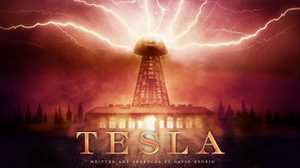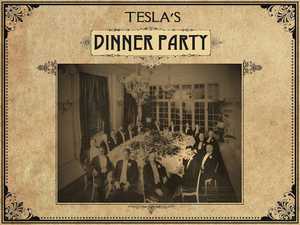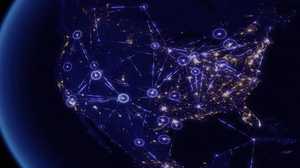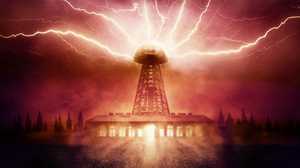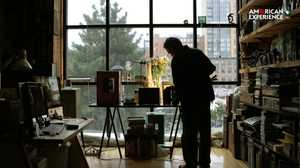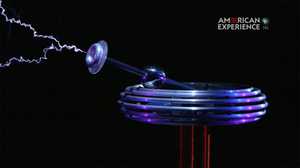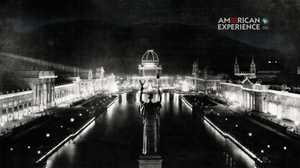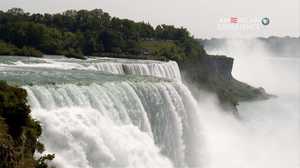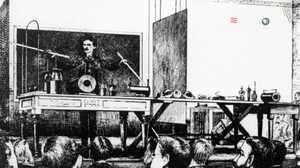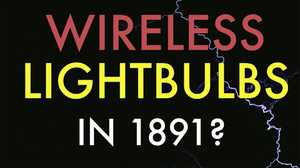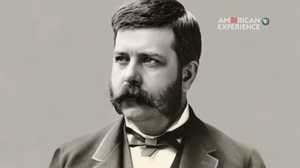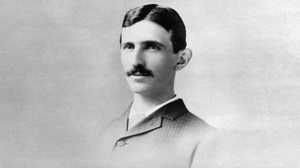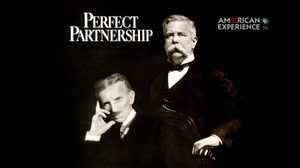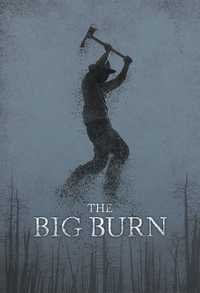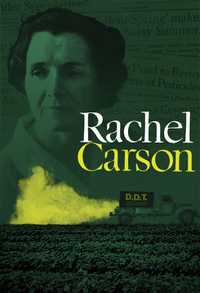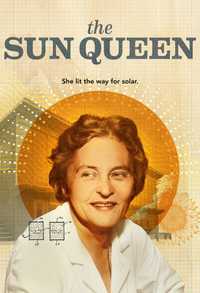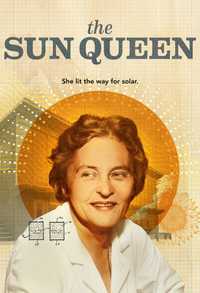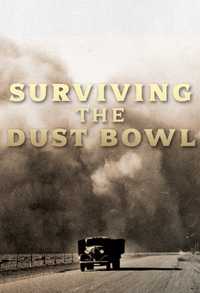Narrator: In 1891, a Serbian scientist demonstrated his latest inventions before an awestruck audience at Columbia University.
"Tubes… held in the hand of Mr. Tesla," a reporter wrote, "appeared like a luminous sword in the hand of an archangel representing justice."
Nikola Tesla was already famous – the scientist whose experiments with electricity were destined to transform daily life in the 20th century.
Marc Seifer, Biographer: We live in an electrical world. We take it all for granted. We have light bulbs, we run our refrigerators, our air conditioners, our electrical motors. All of that is all directly back to Tesla.
Narrator: A hundred years ago, he pointed the way toward robots, radio, radar, remote control, the wireless transmission of messages and pictures. He dreamed of harnessing the wind and the sun to make free energy available for everyone.
Peter Fisher, Physicist: When you think about electricity you think of Edison. But Tesla was just more of an original American than Edison.
Jill Jonnes, Historian: Tesla had a lot of obsessions and odd phobias and yet he was enormously popular and celebrated. They did not stop him.
Narrator: At the turn of the 20th century, Tesla was acclaimed, millions of Americans knew his name. But only decades later, he was forgotten by all but a few.
John Staudenmaier, Historian: He doesn’t have a disciplined imagination. He has a fertile imagination. And so he gets kind of crazy. Oh, he is a genius, no doubt about it. But he’s an idiosyncratic genius.
Narrator: His luxuriant imagination was the source of his genius, and the cause of his downfall.
On June 6th, 1884, 28-year-old Nikola Tesla arrived in New York City, one of the millions of immigrants who had begun to transform the fabric of American society during the final decades of the 19th century.
The young immigrant knew no one.
Six feet 2 inches tall, he spoke with a heavy Serbian accent and weighed little more than 140 pounds.
Samantha Hunt, Writer: He’s very tall, gangly, handsome. Looks like a vampire a little bit.
Narrator: "What I saw was… rough, and unattractive," Tesla wrote. "‘Is this America?’ I asked myself in painful surprise.
Jill Jonnes, Historian: Everything about him is fastidious and courtly. He’s very elegant looking. He’s got these amazing blue eyes that people notice.
Narrator: Tesla had only four cents in his pocket along with some of his favorite poems, but he carried with him a recommendation to the man he admired more than any other. Thirty-five year old Thomas Edison was already a celebrated inventor, an American folk hero.
The incandescent light bulb he had patented 5 years before had captured the imagination of people all over the world.
Jill Jonnes, Historian: Light was always associated with flame. And Edison, by inventing a light bulb was going to shift the country away from natural gas and gas lighting to a world in which there would be electricity and electric light bulbs in every household. And this was very astonishing to people. It was a miracle.
Peter Fisher, Physicist: Electricity was very mysterious at the time.
My grandmother, born in 1900 maybe, insisted that we always have those child proof things in the plugs because she thought the electricity was dripping out and it would collect on the floor and you’d step in it.
Narrator: Tesla meandered down the lanes of lower Manhattan heading toward Edison’s office with a revolutionary idea he was certain the celebrated inventor would be grateful for.
Beneath the ground ran 80,000 feet of copper conductors - the world’s first electric grid, Thomas Edison’s creation - lighting homes and powering factories on the lower tip of Manhattan. But Edison’s system generated direct current – DC – and DC had severe limitations.
Jill Jonnes, Historian: Direct current couldn’t go very far. You would have had to have a generating station every mile. It was a very limited form of power. So this was a real problem. And Tesla had the solution, a brilliant solution.
Narrator: With Direct Current, a generator produces electricity – a stream of electrons – that flows along a wire to a light bulb, or a motor, and then returns to the generator in one long continuous loop. But as the electrons travel, energy is lost to the resistance of the wire. Like a long river whose energy is spent the farther the current travels. The alternative to DC is AC, alternating current.
With alternating current, the electrons don’t flow in a single direction. Instead they vibrate back and forth, like an ocean tide, surging with power that could send electricity long distances. But no one had designed a motor that could run efficiently on AC. Even Thomas Edison himself was baffled.
But in a waking vision, Nikola Tesla had imagined an AC motor when he was 26, two years before he met Edison - as if he had been waiting for that astonishing revelation since he was a small boy in Croatia.
He was born in the tiny Croatian village of Smiljan in 1856 - as family stories have it, on the stroke of midnight while a thunderstorm raged around him.
"He’ll be a child of the storm," the midwife said. His mother responded, "No. Of light."
His father was a Greek Orthodox priest who wanted his son to follow in his footsteps. But he took after his mother, who invented a variety of ingenious devices for farming and housekeeping and encouraged the boy’s precocious gifts.
Jill Jonnes, Historian: Tesla takes his lifelong obsession with electricity back to when he was three years old and he is petting the family cat, Macak. And he begins to create sort of this sheet of sparks. And it makes this crackling noise like thunder. And he says to his father, "What is that?" And his father said, "Well, it’s electricity such as you get during thunderstorms. And stop that because you’re, you know, electrifying the cat."
Narrator: For the rest of his life, Tesla would be awestruck by the wonders of electricity.
As a child, he spent hours playing beside a tumbling stream that ran beside his home. His very first invention – a hook designed to catch frogs – made him the envy of his friends. Before he was six, he had invented a motor consisting of a rotating spindle powered by June bugs.
"I wanted to harness the energies of nature to the service of man," he wrote later.
Marc Seifer, Biographer: You can see the seeds of a number of his inventions when he was a child. But he sometimes had difficulty separating reality from his own imagination.
Narrator: "Sometimes," he wrote, "I was quite unable to distinguish whether what I saw was tangible or not."
From an early age, he was afflicted by spontaneous, inexplicable visions that confused his picture of reality, yet empowered his preternatural gift for invention.
When he was 12, in an extraordinary feat of mind-control, he banished the images that haunted him by willing himself to live in a visual world of his own invention.
Samantha Hunt, Writer: He could travel in his own visions, travel to foreign countries, understand foreign languages, and having control over these visions spurred on his creative energy in later life.
Narrator: By the time Tesla was seventeen, he had honed a keen visual facility.
"When I get an idea," he wrote. "I do not rush into actual work. I start at once building it up in my imagination. I change the construction, make improvements and operate the device in my mind."
Peter Fisher, Physicist: Early in his life he developed this really magnificent way of visualizing physical things. By the time it came for him to build them they came almost fully formed.
Narrator: When he was 21, Tesla won a scholarship to a Polytechnic Institute in Graz, Austria. He studied with a fierce determination - sometimes 20 hours a day.
Samantha Hunt, Writer: Tesla couldn’t stop learning, he couldn’t stop reading. He memorized all of Faust. His memory was photographic and unassailable. He would see something once, he would hear something once and it never left him.
Marc Seifer, Biographer: He was obsessive so once he started to read Voltaire he had to read every single thing that Voltaire ever wrote.
Narrator: As Tesla immersed himself in the study of mathematics and science, the mysteries of electricity were waiting to be unraveled.
When a professor told his class that it was impossible to construct a motor that could run on alternating current, Tesla objected.
"Mr. Tesla may accomplish great things," the professor told the class, "but he certainly never will do this." Tesla disagreed.
Peter Fisher, Physicist: He’s pushing it with the professor. He’s saying ‘I see.’ And this is visionary. He’s saying, "I can do this."
Narrator: At first, he didn’t see the solution, but he saw the problem. DC motors waste energy.
Peter Fisher, Physicist: … there’s metal surfaces moving over each other and they kind of do this and there’s… there’s sparks, it smells, it breaks, it wears out. It’s a clunky, inelegant way to do it. He’s thinking that really wants to be AC. And he almost kills himself trying to make it work.
Narrator: "Day and night, year after year, I worked incessantly," he wrote later.
"I could visualize motors and generators, the images I saw were to me perfectly real and tangible. Solving the problem of alternating current was a matter of life and death. I knew that I would perish if I failed."
Obsessed, he stopped studying, lost his scholarship, dropped out of school, and drifted. He was falling into a hallucinatory, mind-shattered space, and suffered, in his own words, "a complete nervous breakdown."
For 4 years, Tesla’s imagination tormented him. And then, it saved him.
In 1882, walking in a Budapest park as the sun was setting, the solution, he wrote, "came like a flash of lightning." "I cannot describe my emotions."
"A thousand secrets of nature I would have given for that one which I had wrested from her at all odds and at the peril of my existence."
Peter Fisher, Physicist: I think he sees some kind of intrinsic beauty to an AC motor.
I think that’s where you really see this… this famous Tesla insight and intuition.
Narrator: Tesla’s genius was to take a DC motor and reimagine it.
He eliminated the mechanical parts where metal rubbed against metal, replaced the inner cylinder with one made of copper, and sent an electric current through the outer ring, turning the outer ring and the cylinder into magnets.
The interaction of the two magnets made the inner cylinder spin without any parts touching.
Peter Fisher, Physicist: Imagine a merry go round, okay? So and you want to spin your kid around and there’s a pole sticking up from the merry go round so you grab the pole here and you push it across like that. And the merry go round goes around and you wait until the pole comes and then you grab it and push it again, okay?
So you can think of the pole as the electromagnet on the cylinder and you are the magnet on the outside and you’re timing your grab. Because if you just… if you grabbed it here, you know you wouldn’t be able to push, you’ve got to grab it like that...So that’s the way an AC motor works. No sparking, no smell, nothing wearing out. He really just saw the whole thing in an instant.
Narrator: Tesla was a 26-year-old with an idea he was convinced would change the world.
He went to work as an engineer for a branch of Thomas Edison’s company in Paris, but decided his main chance lay in NY with the great man himself.
Jill Jonnes, Historian: He has a design in his head and he’s actually made a prototype which works. He is a huge admirer of Thomas Edison. He feels, if Edison is presented with better technology he will embrace it as something that he could develop in his own company, presumably with the help of his very junior employee, Nikola Tesla.
Narrator: In the spring of 1884, Nikola Tesla brought his invention to America to share with his hero - Thomas Edison.
Jill Jonnes, Historian: This is late 19th century America in New York City. There’s a tremendous sense of possibility and it’s an age of incredible invention and technological change. And he totally expects to be part of that.
Narrator: Tesla walked confidently into Edison’s office in lower Manhattan the very day he arrived, and flashed a letter of introduction from Edison’s Paris office.
Meeting Edison, Tesla said, "thrilled me to the marrow."
Edison hired him on the spot.
But they were cut from two different molds.
Jill Jonnes, Historian: Edison was a completely practical man and inventor. He wanted to make things work and sell them. Tesla really just wanted to understand how the mysteries of electricity worked.
Harold Clark, Scientist: Tesla was a very well educated engineer. He understood both theory and mathematics. Edison did a lot by trial and error. He was able to work well with things when he could see the cause and effect immediately. He wasn’t nearly as well educated. He didn’t even go to college
Jill Jonnes, Historian: Edison, as he gets to know Tesla, refers to him, and this is not particularly a complement, as a poet of science.
Narrator: Tesla worked for Edison redesigning generators, 20 hours a day, 7 days a week.
"I have had many hard-working assistants, Edison told him, "but you take the cake."
Encouraged, Tesla worked even harder. He desperately wanted Edison’s blessing as an inventor - and needed his savvy as a businessman.
But when he described his AC motor to his boss, Edison told him bluntly he was wasting his time. There was no future in alternating current.
Jill Jonnes, Historian: Edison had a lot of experience in how incredibly difficult it was to go from the idea to the reality. And so he was very skeptical of people who just said, "Ah, well I have this idea and this is going to be the solution." And it also would have meant that he had to retrofit and redo the entire system that he was so emotionally wedded to.
Narrator: Disillusioned by Edison’s rejection, after six months, Tesla abruptly quit, and struck out on his own.
Jill Jonnes, Historian: He’s very naïve and doesn’t know how the world works and he thinks that he will be welcomed and well-funded because he wants to elucidate the mysteries of electricity.
Narrator: He spent a year patenting designs for arc lights for two New Jersey businessmen, who cheated him out of patents, and left him penniless. When it came to business, Tesla would always be naïve.
He spent the next winter digging ditches for two dollars a day. "There were many days," he said, "when I did not know where my next meal was coming from."
Samantha Hunt, Writer: When he leaves Edison’s lab his heart is broken. This man who he thought was going to be a mentor to him in some kind of dark, opposite way ends up mentoring him, right? Just by teaching him maybe what he didn’t want to be.
Narrator: Tesla was alone, without family or friends. He had been in America for nearly two years, and had nothing to show for it.
"My high education in science, mechanics and literature, "he wrote, "seemed to me like a mockery."
Then, that spring, his luck turned around.
Two investors who learned that Tesla had worked for Edison took a chance on the Serbian inventor. They made him their partner and rented him a laboratory where he could perfect his invention. If it worked, it was worth millions.
During the last part of the 19th century, as the railroad bound the nation together with steel tracks and made a handful of Americans fabulously rich, 22 year old George Westinghouse had invented the railroad air brake, and parlayed his invention into a formidable fortune.
Now a wealthy man who knew how to bring inventions into the marketplace, Westinghouse was looking to the future, and the future was electricity.
John Staudenmaier, Historian: There were a lot of people saying there’s money to be made here. And Westinghouse comes across Tesla. And he thinks this man is a jewel and he may even have nailed the toughest technical problem in the middle of this emerging, potentially immensely profitable game changer, alternating current.
Narrator: In 1888, Westinghouse bought Tesla’s patents for tens of thousands of dollars, making Tesla a rich man. The contract specified paying Tesla, as the inventor, a bonus: $2.50 for every horsepower of alternating current sold.
John Staudenmaier, Historian: Tesla is someone who has the key technological, creative insight, and what he needs is someone to coach him and someone to fund him.
Narrator: Tesla headed to Pittsburgh, where Westinghouse began building Tesla’s motor along with the dynamos and transformers that would make the long distance transmission of electricity possible. But the struggle to make Tesla’s invention a commercial success was far from over.
Westinghouse was competing for the market with Edison, and he was in trouble. Electricity was a capital-intensive business, and his company was overextended. His investors were worried.
Samantha Hunt, Writer: Westinghouse goes to Tesla and says, "In order for your dream, your alternating current motor to succeed, I have to – I can’t pay you what I promised you in the contract. I’ll go out of business.
Narrator: Westinghouse asked Tesla to rescind the royalty clause in the contract. Without consulting a lawyer, without hesitating, Tesla agreed.
Samantha Hunt, Writer: Tesla does not try to negotiate, you know. "Okay we’ll move it down from $2.50, I’ll take 10 cents on the dollar." No, he doesn’t negotiate at all; he simply tears up the contract. Their contract was really very, very generous. $2.50 for every horsepower of electricity produced. It would have made Tesla one of the richest men in history.
John Staudenmaier, Historian: He was naïve and also tended to think he could break the state of the art any morning before breakfast.
Narrator: Just months after relinquishing his royalties, Tesla appeared at Columbia University to demonstrate his new wonders, determined to astonish an audience of engineers along with a few influential investors.
Peter Fisher, Physicist: A lot of the reason for the demonstration was to get patronage. It was really what scientists were doing in the time. In the air was this American sensibility of show me.
Yeah you can write your fancy European words, you can write equations, you can publish in some journal that nobody reads. I want to see it. Show me.
Narrator: Tesla had begun to explore the possibility of transmitting energy without wires.
"Here is a simple glass tube," he told his astonished audience. "Wherever I move it in space, its soft, pleasing light persists with undiminished brightness."
Harold Clark, Scientist: People were used to incandescent lamps, lamps with filaments, but this idea of a light bulb with no filament that could turn on with absolutely no connection to wire or to a battery?
Narrator: The lamps were Tesla’s own invention, the forerunners of today’s fluorescent tubes. Incandescent bulbs glowed hot. Tesla called his tubes "cold light."
Jill Jonnes, Historian: Cold light is a bulb with gasses in it and when electricity is nearby it lights up. It’s also wireless. You don’t have to have all kinds of wiring to make it work. You just have to have ambient electricity.
Narrator: Ambient electricity – an electric field was created by another Tesla invention.
Peter Fisher, Physicist: He invented this device called the Tesla coil, which enabled him to generate enormously high voltage. It could take low AC voltage and build up inside the coil an enormous amount of energy and then through a spark discharge release all of that energy very, very quickly.
Narrator: As one reporter put it, Tesla acted "the part of a veritable magician."
Narrator: Like a good showman, Tesla wanted to leave his audience dumbfounded. He stretched out his hand, and took hundreds of thousands of volts of electricity directly through his body.
Harold Clark, Scientist: Tesla was apparently unhurt by the whole thing that was pretty amazing to people. Of course, he knew the secret. It’s called the skin effect. His body was taking the electricity and it was literally running through his skin from his hand down to the ground and not entering the internal parts of his body where it really could do some… some real damage.
Peter Fisher, Physicist: I’ve done things like that, and it hurts like hell. Maybe Tesla was just hurting like crazy, but the real danger with electricity is if you grab something that’s at a high voltage it causes your muscles to contract and in particular your heart and so your heart can stop.
John Staudenmaier, Historian: The boundary between gee whiz, gosh, bang, I can make magic happen, and the careful laboratory verification of results was not all that cleanly defined. At that time electricity is still somewhere between magic, science and business.
Narrator: Tesla concluded his three-hour lecture with a paean to electric energy, and its beneficent future as a servant of mankind.
"Everywhere is energy," he said. With the power derived from it, humanity will advance with great strides. The magnificent possibilities expand our minds, strengthen our hopes, and fill our hearts with supreme delight."
Harold Clark, Scientist: Tesla was motivated by wonder and awe at nature. He really wasn’t in this to make money. He really felt that there should be a way, given how powerful nature is, to harness that power and then use it to relieve human suffering and toil.
Narrator: On May 1, 1893, as a great choir broke into song, President Grover Cleveland flicked a switch and 160,000 light bulbs lit up the evening sky over Chicago, opening the Columbian Exposition.
The Exposition signaled the coming triumph of alternating current over direct current.
Westinghouse had outfoxed Edison, winning the contract to wire the Exposition with alternating current. Twelve, seventy-five ton dynamos generated three times more energy than the entire city of Chicago.
Six months later, Westinghouse went on to win a greater prize. The contract to harness Niagara Falls to generate alternating current electricity.
Jill Jonnes, Historian: Tesla worked with the engineers, perfected all of these dynamos and motors and helped design everything. The water powered the water wheels and that powered the generators and the generators sent out electricity. At that point DC was a technology that was defeated. Alternating current triumphed.
Marc Seifer, Biographer: Before Tesla you would have to have thousands of little power plants at every mile. After Tesla from one power source, Niagara Falls, you could light up and power the entire northeast.
Narrator: The modern world was born. Alternating Current transformed daily life in the 20th century, and made Tesla famous. Tesla was all at once a celebrity, a new Edison.
Jill Jonnes, Historian: He was enormously famous, incredibly charming, mesmerizing, and funny. He speaks many languages, loves poetry. He’s just an all-around renaissance man that people are very drawn to. He’s very beloved of newspaper reporters because he could go on for hours on almost any topic and have something interesting and insightful to say.
Narrator: Tesla was fond of luxury: he lived in the Astor House, the city’s first luxury hotel, and dined at Delmonico’s, the lavish restaurant of choice for fashionable New Yorkers.
Resplendent in his cutaway coat and striped dress pants, he was the darling of New York society, a regular at the glittering tables of the super rich… men like John Jacob Astor and JP Morgan.
Jill Jonnes, Historian: He needed to be supported. He needed to cultivate and persuade these very powerful industrialists that he was worthy of being invested in.
Narrator: 37 years old, Tesla devoted his prodigious energies to creating new inventions in his laboratory in lower Manhattan, where he passed long, solitary hours. And delighted in showing off his experiments to friends - artists, writers, society figures, the luminaries of his day, among them Mark Twain.
Marc Seifer, Biographer: Stars of the Gilded Age came to his laboratory. And Tesla was a star among these stars.
Narrator: Tesla continued inventing, securing patent after patent, yet he was peculiar, dogged by troubling, persistent obsessions.
Jill Jonnes, Historian: He was enormously popular and celebrated, but he had a lot of odd phobias and routines. Everything that he does should be divided by three. If he was staying in a hotel the room should be divisible by three.
Harold Clark, Scientist: In his younger days he would swim in the morning and he always did 27 laps because it was divisible by three.
Marc Seifer, Biographer: He would circle a block three times before entering a building.
Samantha Hunt, Writer: He had horrible germ phobia. He couldn’t stand the sight of women’s earrings. He couldn’t stand the idea of touching human hair.
Marc Seifer, Biographer: I don’t like to use the term obsessive compulsive, but he was.
Samantha Hunt, Writer: He had a lot of restrictions keeping him away from actual humans. Despite being a great humanitarian, Tesla had a lot of issues with humanity.
Narrator: Tesla was a romantic, but romance had no place in his life.
"I do not think there is any thrill, he told a reporter, "like that felt by the inventor as he sees some creation of the brain unfolding to success. Such emotions make a man forget food, sleep, friends, love, everything."
"It’s a pity too, for sometimes we feel so lonely."
In 1899, Tesla headed West. He had enormous ambitions, and they were growing too big for his New York laboratory.
43 years old, once again, he imagined an invention that he believed would change the world.
He set up shop outside of the resort town of Colorado Springs, checked into the Alta Vista Hotel - room 207 - a number divisible by 3 - and went to work. In a laboratory built to his specifications on the outskirts of town, he conducted a series of experiments in great secrecy.
Jill Jonnes, Historian: He built this lab where he could generate huge amounts of electricity and built this huge fence around it saying, "Keep out."
And where did he get the money to do this? By telling John Jacob Astor IV that he was now going to develop his cold light and the cold light was so superior to the Edison bulb and just think of the millions of light bulbs that were sold every year that would be displaced by the cold light.
Narrator: But Tesla had no intention of profiting from a paltry thing like fluorescent lighting. He soon had his coils producing a million volts of electricity. Errant bolts set his laboratory on fire. He drew so much power that he once plunged the entire town of Colorado Springs into darkness.
Using high voltages, Tesla theorized that he could transmit electricity vast distances by sending electric currents through the earth.
Peter Fisher, Physicist: You have this Tesla Coil and there’s this enormous spark across the room. That’s a current. The current makes a magnetic field. That magnetic field spreads out. If the current is large enough it can go miles, and light a bulb.
Jane Alcorn, President, Tesla Science Center at Wardenclyffe: He set up an experiment where he had some light bulbs in a field. And they were surrounded in a 50-foot square of wire. And he transmitted power so that an electrical field was created within that wire and the bulbs lit up.
That was one of the things that led him to believe that he would be able to accomplish this on a wide scale.
Narrator: At the end of eight months of experimentation, Tesla announced that he had proved that he could transmit electric power abundantly and cheaply anywhere on the planet. But he never produced the evidence to make his case.
Peter Fisher, Physicist: This is where Tesla didn’t do so well. He really thought he was on to something. I think his picture was pretty much wrong. I think he fooled himself.
Harold Clark, Scientist: The problem is a physics problem: the farther you get away from the source, the weaker and weaker the electricity gets.
Peter Fisher, Physicist: Tesla is of the school that once he believed he had some evidence for something he was very quick to promote it, expound it to the world and not at all interested in challenging it.
Narrator: Tesla was damaging his credibility. He tarnished it even further by claiming that late one night, he received signals from Mars.
Harold Clark, Scientist: His instrumentation was doing some weird flipping around and he was claiming that it was communications from space. It may have been gamma rays or cosmic rays, even radio waves. The fact that he interpreted it as communication from alien beings or Martians made people begin to doubt him.
Narrator: His fertile imagination, so critical to his inventive powers, was betraying him. That same year an Italian electrical engineer, Guglielmo Marconi, sent a wireless message across the English channel. Tesla dismissed him. Marconi possesses "more enterprise than knowledge… Let him continue. He is using seventeen of my patents."
In the year 1900, 44-year-old Nikola Tesla returned to New York City. He had burned through $100,000 in 8 months in Colorado Springs. Now, he was looking for many hundreds of thousands of dollars more.
Jane Alcorn, President, Tesla Science Center at Wardenclyffe: Without using wires, without using any other means of transmission than the Earth, he wanted to send electrical power and wireless messages around the globe. And he believed he could do this based on the experiments he had conducted in Colorado Springs.
Narrator: Settling into the luxurious Waldorf-Astoria Hotel, Tesla started looking for investors. But raising capital would not be easy. Heedless, he was making more and more extravagant claims. He repeated that he had received signals from Mars, and insisted that he had the apparatus to signal the Martians back.
Jane Alcorn, President, Tesla Science Center at Wardenclyffe: He also foresaw the transmission of pictures and sound, music, images and voices, real time. But for investors, you have to have something that seems a little more realistic and concrete. How do you explain a vision?
Narrator: Tesla’s reputation as a scientist was on the line.
Jill Jonnes, Historian: At this point Tesla has not had a commercially successful invention in a number of years. And as he tries to get new people interested in investing in him they’re less than enthusiastic because they feel that he’s just going to take their money and vaporize it.
Narrator: But JP Morgan, the most powerful financier in America, was intrigued. Tesla’s breakthrough with alternating current was worth millions. Morgan wanted to hear what the eccentric inventor was proposing now.
Tesla told him that he had designed a small tower to transmit wireless messages.
He kept secret his intention to transmit electric power wirelessly – to make unlimited electricity available free to anyone with an antenna.
Jane Alcorn, President, Tesla Science Center at Wardenclyffe: Tesla’s basic idea was to give energy for free for the betterment of humanity. But he wasn’t going to be able to sell this idea to Morgan. He was playing to what Morgan’s interests were.
Narrator: Morgan invested $150,000 towards what he thought would be the wireless transmission of messages. But warned that $150,000 was his limit. With Morgan’s money, Tesla bought 200 acres on Long Island’s north shore. He called it Wardenclyffe, after its former owner, and began building a transmission tower.
Jane Alcorn, President, Tesla Science Center at Wardenclyffe: He also intended to have a manufacturing facility. But JP Morgan’s $150,000 was never going to complete what Tesla had in mind. And I’m sure that when he took that money he thought there’d be more following once he achieved some measure of success.
Narrator: But a triumphant Guglielmo Marconi doomed Tesla’s dream.
On December 12, 1901, Marconi sent the first wireless transmission across the Atlantic, based on Tesla’s patents. Eight years later, Marconi would win the Nobel Prize for the invention of wireless telegraphy – radio.
Jill Jonnes, Historian: And the minute JP Morgan sees that he’s done with Tesla. So there’s no more money coming from JP Morgan.
So Tesla is in a very bad place. This is where had he retained his royalties for alternating current he would have had all the money he needed to do whatever he wanted. But he didn’t and he wrote just these ever more pathetic, pleading and insulting and bitter letters to Morgan. I mean, almost like what you would expect, you know, a crazy divorced person to write.
Narrator: "Have you ever read the book of Job?" he wrote. "If you will put my mind in place of his body you will find my suffering accurately described. With $ 50,000 more Wardenclyffe is completed, and I have an immortal crown and an immense fortune. You are a big man, but your work is wrought in passing form, mine is immortal."
John Staudenmeier, Historian: Tesla didn’t know how to work with the JP Morgans of his era and what it would take to keep them on board. He didn’t know how to think about his technology from the perspective of people that would fund it, finance it. Part of creativity is understanding how you can fit it into the world of practice. It was a big flaw in his life.
Narrator: In the summer of 1903, just as he finished making his first experiments, Tesla ran out of money.
Harold Clark, Scientist: His experiments on Long Island were never finished. But what he was trying to do there was pretty far out.
Peter Fisher, Physicist: Messages might have been possible, because to send a message you need a tiny, tiny, tiny amount of power. But I don’t think there was any way that he was going to put sufficient power out of this thing so that he was going to be able to go even a mile.
The insight he demonstrated for the AC motor is true genius but his dream of powering things over vast distances really wasn’t workable and I’ve always been curious why he even though that was possible.
Narrator: Still Tesla dreamed of Wardenclyffe, trying desperately for years to raise the money to resurrect his vision. "I will be able to transmit energy of any amount to any place," he said. Tesla believed the tower would also be powerful enough to send signals to nearby planets, especially if there were any Martians out there to receive them.
In 1916, his fortune dwindling, he relinquished the Wardenclyffe mortgage to the Waldorf Astoria Hotel, where he had been living on credit for almost 20 years, running up a debt of $20,000. The following year, to make the land easier to sell, the Waldorf had the tower dynamited.
Tesla was 61. He would spend the rest of his life imagining new inventions, and hoping to find someone to invest in them.
Jill Jonnes, Historian: He consulted with various companies. But he was a lonely, eccentric scientist who really was frustrated that his ideas had never been fully seen through.
Marc Seifer, Biographer: His goal was to try and sell something so he could get the money, go back to Wardenclyffe and complete his baby, which was a world global system to transmit light, voice, pictures and power to all points of the globe.
He was trying to attach our technology to the wheelwork of nature - harnessing geothermal power, the tides, the wind, and sun. He did not want to sap the Earth of our natural resources. He stands for the future.
Narrator: Tesla still commanded attention, but increasingly, his ideas were losing their mooring in reality.
Samantha Hunt, Writer: Science and science fiction meet in Nikola Tesla. As time goes on his inventions start to take on more of the fantastic. They are visions. They take full flight. They unleash themselves from the strictures of reality.
He starts to develop an idea about photographing thought, which is one of his most poetic and beautiful non-inventions in my book. He thinks, you know, thought is electrical energy and we record electricity all the time, why can’t we photograph thought?
Narrator: Tesla had never cared about money. Now, he had hardly any left. Leaving behind a trail of debts, he moved from one hotel to another. His mind was drifting.
Samantha Hunt, Writer: Despite the fact Mark Twain is dead, Tesla is sending him packages to an address that no longer exists in New York City. He’s living with ghosts.
Narrator: His only friends were the pigeons in Bryant Park.
"I have been feeding pigeons, thousands of them, for years," he told a reporter. "One was different. It was a female. I loved that pigeon as a man loves a woman, and she loved me. As long as I had her, there was purpose to my life." The night his beloved pigeon died, he saw a light in her eyes he described as more intense than the most powerful lamps in his laboratory. When that light went out, he said, a light went out inside of me.
Nikola Tesla died on January 7, 1943. He was 86 years old, alone in the New Yorker Hotel, room 3327 on the 33rd floor.
Six months later the United States Supreme Court ruled that the patents to Marconi’s wireless device belonged to Tesla. Tesla, not Marconi, invented radio. But by now, he was nearly forgotten. His coils were never commercially successful; his fluorescent lights never marketed; his wireless system never realized; his invention of radio never fully credited. Even today, his achievements remain obscure.
Samantha Hunt, Writer: Alternating current electricity is not something you think about every time you put your hand on the light switch and turn on the lights. There’s not something that’s easy to say, "Ah, okay, there. There we are. There’s the Tesla, that’s what he gave us."
Harold Clark, Scientist: He established the basic framework for electrical generation and distribution that drives our economy today. But he was moving down his own path. He was pursuing a vision.
He didn’t necessarily always see the gaps that would have to be filled in order to get where he was going but he always believed that he could get there.
Narrator: His imagination carried him beyond his time. With over 200 patents, Tesla had an exhilarating sense of the future. But a long road of invention had to be travelled before many of his ideas could be realized...
Jill Jonnes, Historian: Tesla resonates with our own time. Many of the things that he predicted are being brought to reality by the current generation.
Peter Fisher, Physicist: Wireless networking, cell phones ... yeah I think that’s what brought Tesla back to us was that his dream came true.
Samantha Hunt, Writer: He was an artist. He’s working with his dreams, he’s working with his visions. His medium is not pigment, his medium is not clay.
His medium is electricity.
Peter Fisher, Physicist: He was like a scientist with an artistic nature and many scientists are driven by that. Absolutely!
Tesla really was a visionary. Enough of his stuff came true. Enough of his stuff came true.
